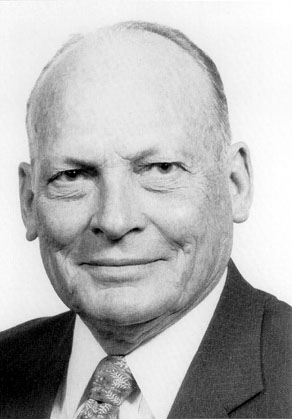
Written by Dennis Desjardin
for the
February, 1998 NAMA Foray
in Asilomar, California

. Harry D. Thiers was born January 22,1919 in Fort McKavett, Texas. He received his B.A. degree from the University of Texas in 1941, served in the U.S. Navy from 1942-1945, and received an M.A. degree from the University of Texas in 1947. He earned his Ph.D. at the University of Michigan in 1956, studying under the tutelage of Dr. Alexander H. Smith. Dr. Thiers' doctoral dissertation was on the Agaricales of the pine belt in eastern Texas.
. As an academician, Dr. Thiers began his career at Texas A&M University where he taught for 12 years. He then moved to California where he taught at San Francisco State University for 30 more years, retiring in 1989. During this period he served as major professor for 35 Master's Degree students, (the highest degree awarded at SFSU), of whom 19 went on to receive their Ph.D. degrees and are now fellow academicians at leading universities and research laboratories.
. Although Dr. Thiers' main interests were in the taxonomy and the evolution of fleshy fungi, his influence through the training of young mycologists is felt in all subdisciplines of mycology. Mycology programs in every university in North America have benefited directly from his research and teaching skills. In recognition of his superior teaching abilities, Dr. Thiers was awarded the W. W. Weston Award for Teaching Excellence by the Mycological Society of America and an Outstanding Teacher Award by San Francisco State University. He is so loved and respected by his colleagues and former students that they have bestowed numerous honors upon him and have established many awards in his name. For example, he was given a Life Membership in the Mycological Society of America (MSA) and a major Festschrift was published by his former students to honor his 70th birthday (Mycotaxon 34: 1-276. 1989). In addition, the H. D. Thiers Scholarship was established by the Mycological Society of San Francisco, and the Thiers Travel Award was established by the MSA.
. As a researcher, Dr. Thiers has published 8 books and 50 papers in leading refereed scientific journals and innumerable articles for lay journals. He is recognized worldwide as the leading authority on boletes and an innovator in the research on secotioid fungi. Throughout his career he has been in demand to present symposium addresses and keynote lectures at professional meetings all over the world. He has published over 150 new species of fungi based mostly on material that he has collected during his expeditions to Europe, Australasia and throughout North America. Fourteen different taxa are named in his honor, including the genus Thiersia.
. Dr. Thiers has worked extensively on the fleshy fungi of California over the past 40 years, and his research has culminated in the establishment of a series of monographs on California mushrooms entitled "The Agaricales of California." Even in retirement he continues to work on the California mycota, and the hot-off-the-press monograph on the genus Russula is a testament to his fortitude and systematic skills. Upon arriving at San Francisco State University in 1959, Dr. Thiers began building a herbarium that now numbers over 100,000 specimens and is a National Resource Collection. With over 65,000 specimens of fleshy fungi, it is the largest and most important collection of these taxa west of the Mississippi. Because of his seminal role in establishing this major collection of fungi, the herbarium was renamed the Harry D. Thiers Herbarium in 1989.
. During the years 1974-1983, Dr. Thiers served many official roles in the Mycological Society of America, from Councilor and Secretary-Treasurer, to Vice President, President-Elect and finally President. His published presidential address entitled "The Secotioid Syndrome" is one of the more frequently cited papers on the evolution of morphology in fleshy fungi. Because of his outstanding contributions to the field of mycology, the MSA awarded him its highest honor, the Distinguished Mycologist Award. In October of 1998 Dr. Thiers will be awarded the California Academy of Sciences Fellows Medal. This is the highest award bestowed by this prestigious organization, and the first time ever awarded to a mycologist!
. There is no mycologist in North America more committed to educating the public on the importance of fungi than Dr. Thiers. For over 30 years he served as the Scientific Advisor to the Mycological Society of San Francisco. Every year, Dr. Thiers presented several public lectures, conducted workshops on mushroom identification, and led forays throughout North America. He is a world renowned educator, both in the classroom and in public venues, bringing the excitement of learning about our natural world to thousands of people. Likewise, he is a world- class researcher and innovator, greatly advancing our knowledge of the ecology and taxonomy of fungi, especially California fungi. We are pleased to name this year's NAMA foray at Asilomar the Harry D. Thiers NAMA Foray in his honor.
D. E. Desjardin - February, 1998
Revised version presented with permission of Dennis Desjardin
and the North American Mycological
Association -
June, 1998
updated ~g2r